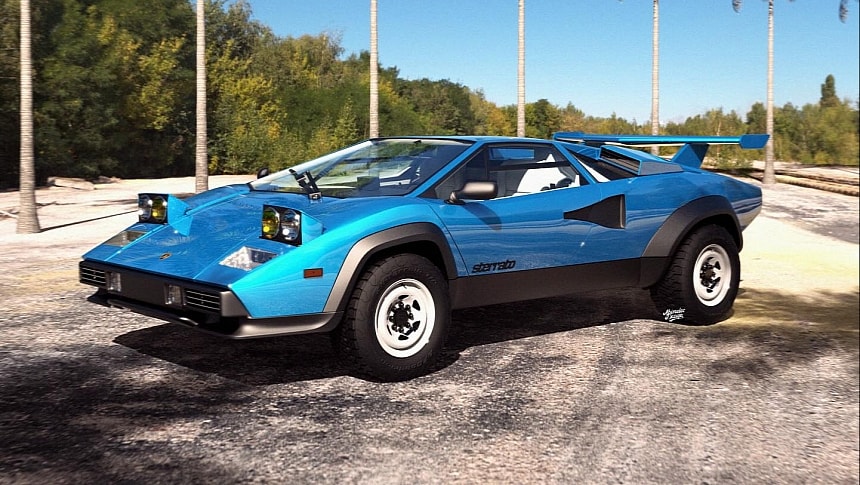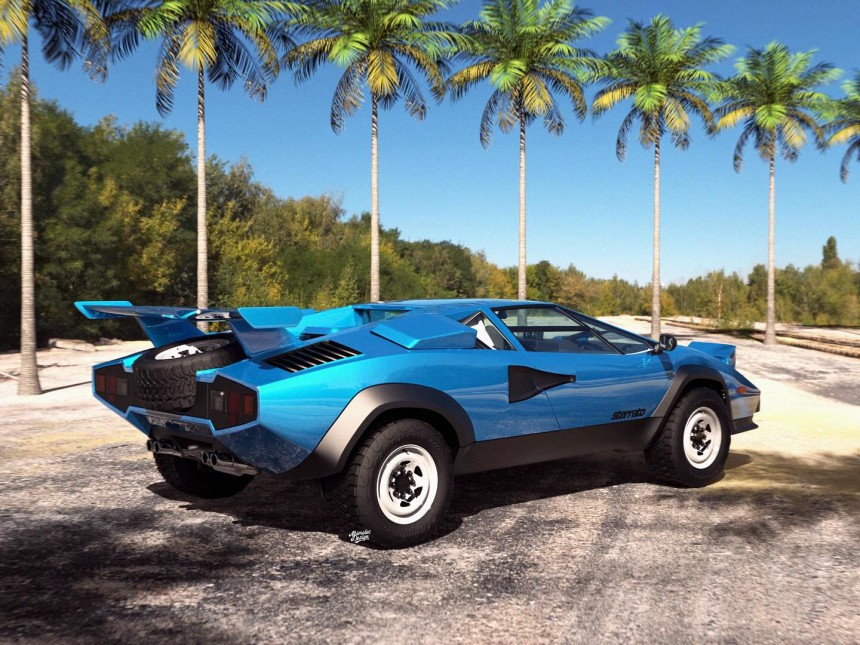Lamborghini has a long and seriously convoluted history of all-terrain vehicles. It all started with the 1977 Cheetah, built on a contract from Mobility Technology International. Turns out MTI blatantly copied the 1970 XR311 from FMC, a military vehicle intended to replace the M151 jeep.
Lamborghini revisited the Chettah to create the LM001 of 1981, a rear-engined 4x4 powered by a free-breathing V8 of AMC origin. Why AMC? Because Automobili Lamborghini was controlled by the Mimran brothers between 1980 and 1987. The French businessmen had close ties to Renault, which acquired a big chunk of AMC in 1979.
Poor handling characteristics forced the Mimrans to discontinue the project after a single prototype was completed. Come 1982, the LMA002 was unleashed with the Countach's V12 engine mounted up front. The Lamborghini Mimran Anteriore 002 paved the way for the series-production LM002 sport utility truck. Only 301 were produced.
A very different animal from its predecessor, the Urus followed suit in 2017 for the 2018 model year with underpinnings and oily bits from the Volkswagen Group. The Italian automaker's latest all-terrain vehicle is the Huracan Sterrato, which is better suited to occasional driving on loose surfaces rather than off-roading on the Rubicon Trail.
In production since February 2023, the Sterrato will eventually number 1,499 units. The assembly line will come to a grinding halt in the second half of 2024. The Sterrato is Lamborghini's final non-hybrid vehicle, for the Urus will go plug-in hybrid and the Huracan will be replaced by a twin-turbo V8 plug-in hybrid supercar. The maddest supercar developed by Lamborghini under the Volkswagen Group's yoke also served as inspiration for Abimelec Arellano's latest rendering, which proposes the Countach in Sterrato flavor.
Allegedly based on the Countach LP5000 S Quattrovalvole, which may be a mistake on the pixel artist's part, the design study is gifted with a 1.75-inch lift, steelies with eight lug nuts per wheel, a full-size spare under the ginormous rear wing, and matte-black fender flares at every corner. The LP500 S is a distinct model from the LP5000 Quattrovalvole, with the S packing a 4.8-liter V12 as opposed to 5.2 liters for the four-valve powerplant.
Fiat Panda 4x4-inspired pitch and roll gauges are the only notable interior changes. From a mechanical standpoint, the biggest change over the real thing is – of course – the permanent all-wheel-drive system. Lamborghini used a two-speed transfer case and a dogleg manual in the LM002, whereas the Diablo VT sports a viscous center diff to transfer 25% of the torque to the front wheels.
The Gallardo makes use of a viscous coupling as well, which shouldn't come as a surprise due to Lamborghini's close ties to Audi. For the Huracan, the Italian automaker switched to an electronically controlled and hydraulically actuated multi-plate clutch for torque distribution. Around 30% goes to the front in regular driving conditions, but the system is capable of diverting up to 50% when needed.
Lamborghini went one step further with the Revuelto. Instead of a mechanical system, the V12-powered flagship achieves all-wheel drive by means of two front axial flux motors. A third electric drive unit is positioned above the transmission. The Huracan's successor is also expected with at least one electric motor up front, but alas, the free-breathing V10 we all know and love will be discontinued in favor of a twin-turbocharged V8.
Poor handling characteristics forced the Mimrans to discontinue the project after a single prototype was completed. Come 1982, the LMA002 was unleashed with the Countach's V12 engine mounted up front. The Lamborghini Mimran Anteriore 002 paved the way for the series-production LM002 sport utility truck. Only 301 were produced.
A very different animal from its predecessor, the Urus followed suit in 2017 for the 2018 model year with underpinnings and oily bits from the Volkswagen Group. The Italian automaker's latest all-terrain vehicle is the Huracan Sterrato, which is better suited to occasional driving on loose surfaces rather than off-roading on the Rubicon Trail.
In production since February 2023, the Sterrato will eventually number 1,499 units. The assembly line will come to a grinding halt in the second half of 2024. The Sterrato is Lamborghini's final non-hybrid vehicle, for the Urus will go plug-in hybrid and the Huracan will be replaced by a twin-turbo V8 plug-in hybrid supercar. The maddest supercar developed by Lamborghini under the Volkswagen Group's yoke also served as inspiration for Abimelec Arellano's latest rendering, which proposes the Countach in Sterrato flavor.
Fiat Panda 4x4-inspired pitch and roll gauges are the only notable interior changes. From a mechanical standpoint, the biggest change over the real thing is – of course – the permanent all-wheel-drive system. Lamborghini used a two-speed transfer case and a dogleg manual in the LM002, whereas the Diablo VT sports a viscous center diff to transfer 25% of the torque to the front wheels.
The Gallardo makes use of a viscous coupling as well, which shouldn't come as a surprise due to Lamborghini's close ties to Audi. For the Huracan, the Italian automaker switched to an electronically controlled and hydraulically actuated multi-plate clutch for torque distribution. Around 30% goes to the front in regular driving conditions, but the system is capable of diverting up to 50% when needed.
Lamborghini went one step further with the Revuelto. Instead of a mechanical system, the V12-powered flagship achieves all-wheel drive by means of two front axial flux motors. A third electric drive unit is positioned above the transmission. The Huracan's successor is also expected with at least one electric motor up front, but alas, the free-breathing V10 we all know and love will be discontinued in favor of a twin-turbocharged V8.












